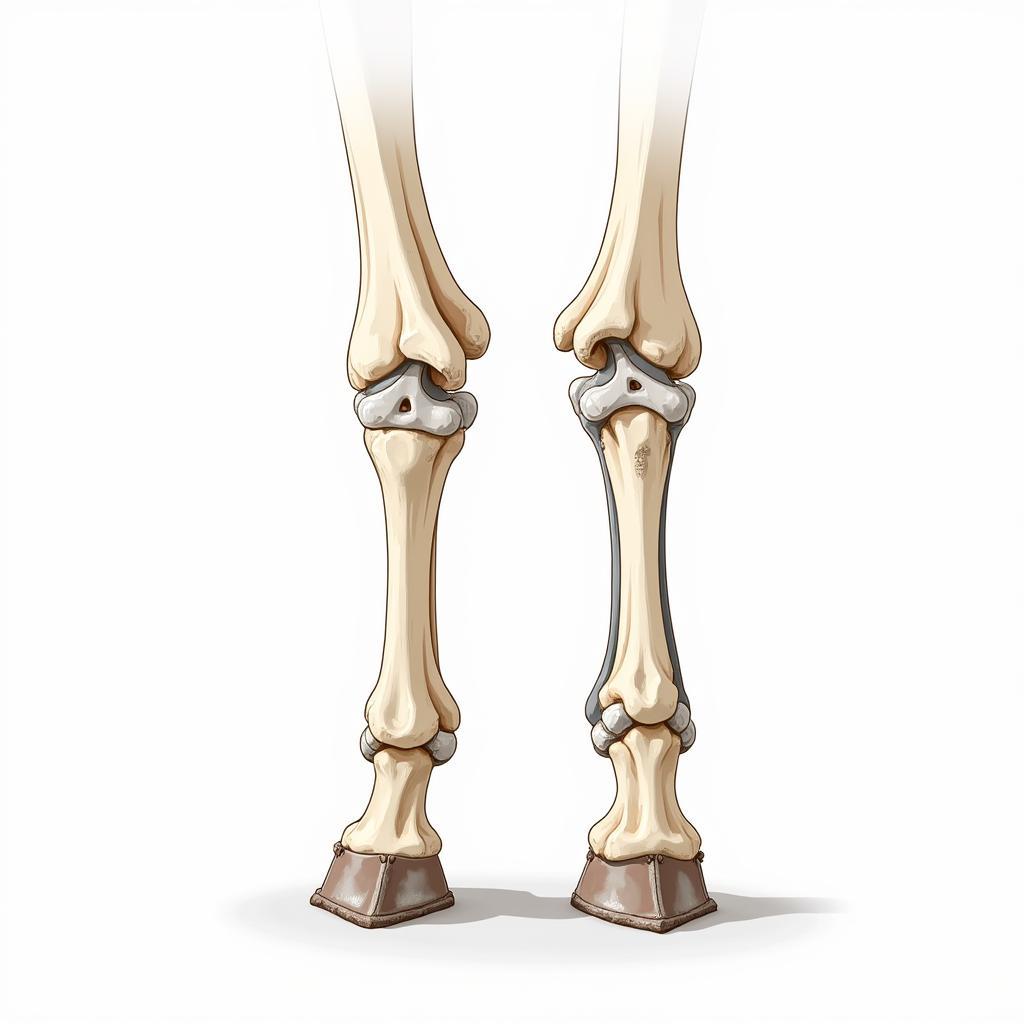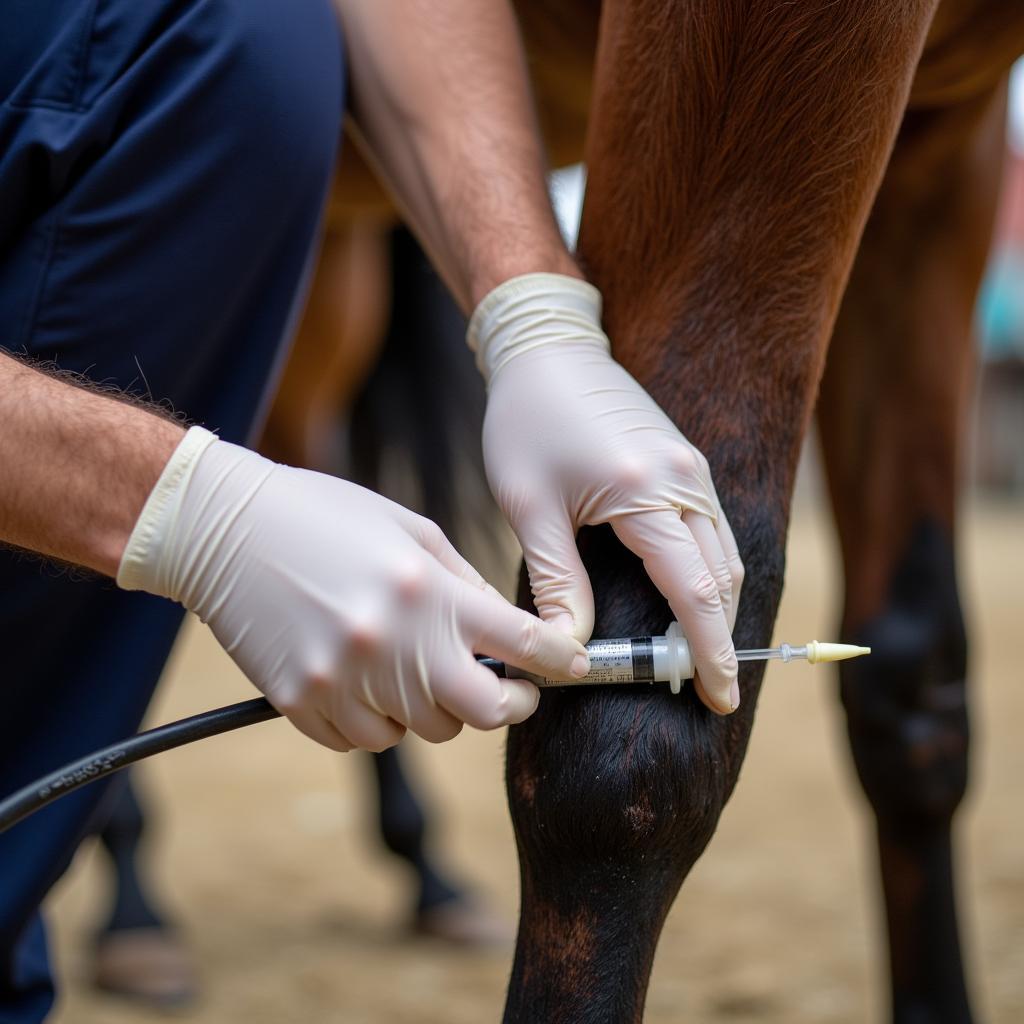Hock injections are a common treatment option for horses experiencing lameness or pain in their hock joints. But what exactly are these injections, and when are they necessary? This comprehensive guide will delve into everything you need to know about Hock Injections For Horses, providing you with the knowledge to make informed decisions about your equine partner’s health.
Understanding the Equine Hock Joint
The hock joint is a complex structure in the horse’s hind legs, analogous to the human ankle. It’s a high-motion joint responsible for bearing significant weight and facilitating powerful movements. Due to its complexity and the stresses it endures, the hock joint is prone to various injuries and degenerative conditions that can cause pain and lameness.
 Horse Hock Joint Anatomy
Horse Hock Joint Anatomy
Common Reasons for Hock Injections in Horses
Hock injections are primarily used to address pain and inflammation within the joint, often caused by:
- Osteoarthritis (OA): A degenerative joint disease that breaks down cartilage, leading to pain, stiffness, and reduced range of motion.
- Spavin: A form of OA specifically affecting the lower hock joints.
- Synovitis: Inflammation of the synovial membrane, which lines the joint capsule and produces synovial fluid.
- Desmitis: Inflammation or injury to the ligaments supporting the hock joint.
- Capsular Injuries: Damage to the joint capsule, which encloses and protects the joint.
Types of Hock Injections for Horses
Veterinarians typically utilize two main types of injections for hock issues:
-
Corticosteroids: These potent anti-inflammatories work by reducing inflammation within the joint, offering rapid pain relief and improved mobility.
-
Hyaluronic Acid (HA): Naturally found in joint fluid, HA acts as a lubricant and shock absorber. Injecting HA into the joint can help restore viscosity, reduce inflammation, and support cartilage health.
In some cases, veterinarians might recommend a combination of corticosteroids and HA for optimal results.
 Administering a Hock Injection
Administering a Hock Injection
Procedure and Aftercare
Hock injections are typically performed on a standing, sedated horse. The veterinarian will thoroughly clean the injection site and administer a local anesthetic for the horse’s comfort. Using sterile techniques, they will then inject the medication into the affected joint.
After the injection, your veterinarian will provide specific aftercare instructions, which may include:
- Rest: Limiting the horse’s activity for a prescribed period, allowing the medication to take effect and the joint to heal.
- Controlled Exercise: Gradually reintroducing exercise to help restore joint function and range of motion.
- Cold Therapy: Applying ice packs or cold hosing to the hock joint to minimize inflammation.
- Monitoring: Observing your horse for any signs of complications, such as swelling, heat, or lameness.
Benefits and Risks of Hock Injections
Benefits:
- Pain Relief: Hock injections can effectively reduce pain and discomfort associated with hock conditions, improving the horse’s quality of life.
- Increased Mobility: By reducing inflammation and pain, injections can enhance joint flexibility and range of motion, allowing the horse to move more freely.
- Delayed Progression: In some cases, hock injections can slow the progression of degenerative joint diseases like osteoarthritis.
Risks:
- Infection: As with any invasive procedure, there is a slight risk of infection at the injection site.
- Tissue Reactions: Some horses might experience mild tissue reactions, such as swelling or heat, which usually subside within a few days.
- Side Effects: While rare, corticosteroids can potentially cause side effects like laminitis, especially with repeated injections.
When to Consider Hock Injections
If your horse exhibits signs of hock pain, such as:
- Lameness: Especially when turning or working on a circle.
- Swelling: Noticeable swelling around the hock joint.
- Heat: Increased temperature in the hock area.
- Pain on Palpation: Discomfort when the hock joint is touched.
- Reluctance to Move: Hesitation or difficulty performing certain movements.
It’s essential to consult with your veterinarian to determine the underlying cause of these symptoms and discuss the suitability of hock injections as a treatment option.
Alternatives to Hock Injections
While hock injections can be highly effective, other treatment options for hock problems in horses include:
- Oral or Injectable Medications: Non-steroidal anti-inflammatory drugs (NSAIDs), joint supplements, and other medications can help manage pain and inflammation.
- Physical Therapy: Various therapies, such as stretching, massage, and therapeutic exercises, can improve joint flexibility, strength, and range of motion.
- Shockwave Therapy: This non-invasive treatment uses sound waves to stimulate healing and reduce inflammation.
- Surgery: In severe cases, surgery might be necessary to address specific joint issues.
 Pain-Free Grazing
Pain-Free Grazing
Making Informed Decisions for Your Horse’s Health
Hock injections can be a valuable tool for managing hock pain and improving your horse’s well-being. However, it’s crucial to have open and honest conversations with your veterinarian. They can assess your horse’s specific needs, discuss the risks and benefits, and help you make informed decisions about the best course of treatment for your equine partner.
Frequently Asked Questions About Hock Injections for Horses
Q: How long do hock injections last?
A: The duration of relief varies depending on the underlying condition and the type of injection used. Corticosteroid injections typically provide pain relief for several weeks to a few months, while HA injections might last for several months to a year.
Q: How many hock injections can a horse have?
A: There is no set limit on the number of injections a horse can receive. However, repeated corticosteroid injections can potentially have negative effects on joint health in the long term. Your veterinarian will recommend an appropriate injection schedule based on your horse’s individual needs.
Q: What is the success rate of hock injections in horses?
A: The success rate varies depending on factors like the severity of the condition, the type of injection used, and individual horse factors. Generally, hock injections are considered a successful treatment option for many horses, providing significant pain relief and improved mobility.
Q: Are there any specific breeds prone to hock problems?
A: While any horse can develop hock issues, certain breeds, such as Quarter Horses, Warmbloods, and draft breeds, might be predisposed to certain conditions like osteoarthritis.
Q: Can hock injections cure osteoarthritis?
A: Hock injections are not a cure for osteoarthritis. However, they can effectively manage pain, reduce inflammation, and slow the progression of the disease, improving the horse’s comfort and quality of life.
Need more information about caring for your horse? Check out our articles on:
For personalized advice and support, don’t hesitate to contact us. We’re here to help you provide the best possible care for your equine companion.
Contact us today!
Phone: 0772127271
Email: [email protected]
Address: QGM2+WX2, Vị Trung, Vị Thuỷ, Hậu Giang, Việt Nam
Our dedicated team is available 24/7 to answer your questions and address your concerns.